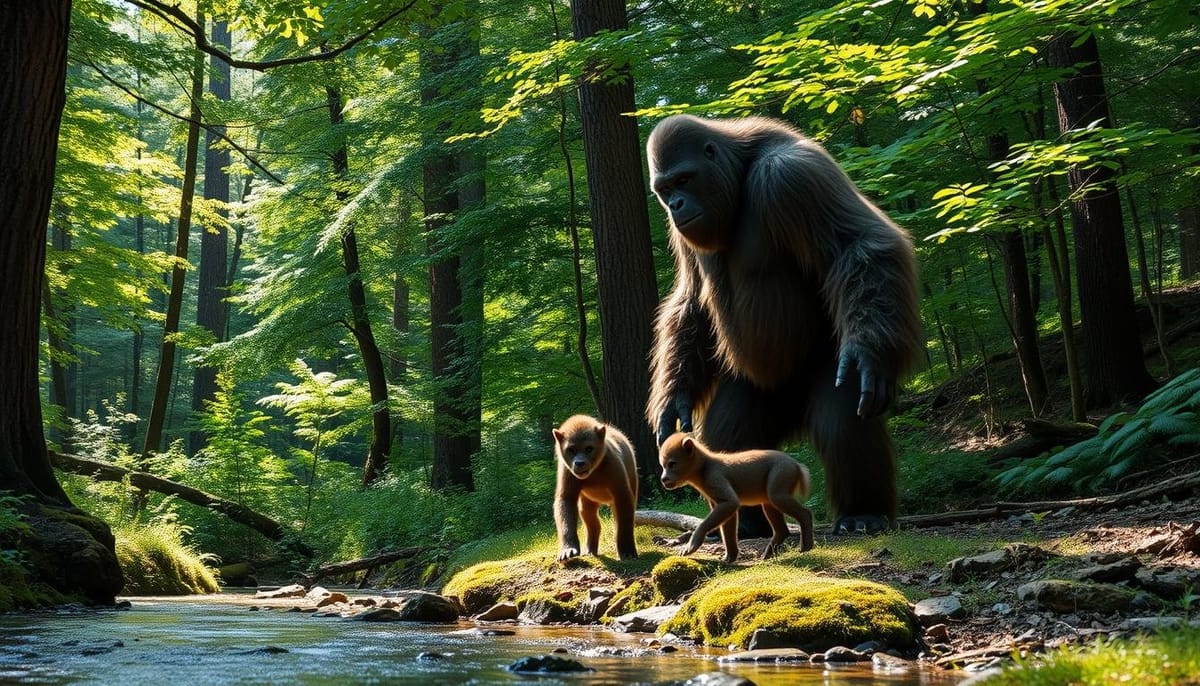Bigfoot Family: Legendary Creatures in the Wild
Explore the mysterious world of the Bigfoot family. Uncover sightings, evidence, and theories about these elusive creatures lurking in North America's wilderness.

Bigfoot, also known as Sasquatch, has fascinated people for decades. These large, hairy, humanoid beings are said to roam North America's dense forests. Especially in the Pacific Northwest. Over 1,700 sightings of Bigfoot have been reported, sparking a community of enthusiasts and researchers.
Bigfoot is described as looking like humans but with ape-like features. It's said to be massive, muscular, and bipedal, covered in dark fur. The largest footprints attributed to Bigfoot are two feet long and eight inches wide, much bigger than a human foot.
Despite the fascination with Bigfoot, science says they are likely folklore, misidentification, and hoax. Yet, the legend of Bigfoot still captures our imagination. Enthusiasts provide dubious evidence to prove they exist.
Origins and Folklore of Bigfoot
The Bigfoot legend comes from a mix of folklore and myths from around the world. The bigfoot family origins are tied to European wild man folklore and indigenous bigfoot myths of North America.
European Wild Man Legends
For centuries, European folklore has told of hairy, humanoid creatures living in the wild. These cryptid legends are known as "wild men" or "woodwoses." They were thought to live in dense forests and mountains, staying away from people.
Indigenous North American Myths
Many indigenous cultures across North America have stories of wild man-like creatures. From the Skunk Ape in the southeast to the Sasquatch in the Pacific Northwest, these tales are old. They were a big part of many Native American tribes' culture.
The Bigfoot legend has grown, mixing these different stories. It has become the famous cryptid that fascinates people today.
Physical Descriptions of Bigfoot
Bigfoot, also known as Sasquatch, is described as a large, muscular creature. It is said to be human or ape-like, covered in black, dark brown, or dark reddish hair. People estimate its height to be around 6–9 feet (1.8–2.7 m). Some sightings even report it standing as tall as 10–15 feet (3.0–4.6 m).
Many believe Bigfoot looks more human than ape, especially in its face. It is often described as having broad shoulders, no visible neck, and long arms. Some think these features might be from a bear standing upright. Some nighttime sightings claim the creature's eyes glow yellow or red, a trait not common in humans or great apes.
Bigfoot's footprints are said to be huge, up to 24 inches long and 8 inches wide. Some casts show claw marks, similar to those of bears. The name "Sasquatch" comes from the Salish word se'sxac, meaning "wild men." The legend grew in 1924 after an incident involving "gorilla men" on Mount St. Helens, Washington.
Scientists usually don't believe in Sasquatch, seeing it as a hoax or a mix-up with bears. Yet, the cryptid characteristics of Bigfoot have sparked many horror films, comedies, and books. They have also been in commercial ads, keeping the public's interest for years.
Sasquatch Sightings and Encounters
Bigfoot sightings have been reported across North America, especially in the Pacific Northwest. These stories come from First Nations communities with long traditions of these creatures. Their tales have kept the legend of Bigfoot alive for many years.
First Nations Accounts
For centuries, indigenous peoples have shared stories of Bigfoot. The Sts'ailes people of British Columbia see Sasq'ets as land guardians. The Lummi people of Washington state tell of Sasquatch as huge, furry beings that roam at night.
The Patterson-Gimlin Film
The Patterson-Gimlin film from 1967 is a famous piece of Bigfoot evidence. It shows a large, two-legged creature walking in a clearing. This has sparked a debate on whether it's real or a hoax.
| Year | Incident | Location | Description |
|---|---|---|---|
| 1955 | William Roe Sighting | British Columbia | Roe claimed to have seen an ape-like creature about 6 feet tall while hiking. |
| 1924 | Albert Ostman Encounter | British Columbia | Ostman stated he spent a week with a Bigfoot family. |
| 1967 | Patterson-Gimlin Film | Northern California | Allegedly captured a female Bigfoot walking, estimated to be 6-7 feet tall. |
Despite doubts, Bigfoot sightings keep fascinating people. They show the mystery of these creatures is still alive.
bigfoot family Theories and Explanations
The elusive Bigfoot, also known as Sasquatch, has captured the public's imagination for decades. Many theories and explanations have been proposed to explain its existence. Some believe it could be a surviving species of hominid or even an interdimensional entity.
However, most scientists think Bigfoot is just a mix of folklore, misidentification, and hoax. Skeptics say that footprints and videos can be explained by known animals or humans. Despite over 10,000 reported sightings in the U.S. in the last 50 years, no solid scientific proof supports Bigfoot's existence.
Many bigfoot theories and sasquatch explanations have been put forward. But the cryptid origins of this creature are still debated. The scientific community remains skeptical, urging caution in interpreting evidence.
https://www.youtube.com/watch?v=d9Ghi7MUk1E
Recent studies have raised doubts about Bigfoot evidence. Most alleged Bigfoot hair samples are from known animals. The famous Patterson-Gimlin film from 1967 is also widely considered a hoax. The lack of solid proof and the presence of hoaxes have led experts to believe Bigfoot is a product of folklore and human imagination.
Despite the ongoing fascination with Bigfoot, scientists remain unconvinced. They call for a more skeptical and evidence-based approach to this mystery. As the search for Bigfoot continues, its true nature remains uncertain, leaving room for further exploration and debate.
bigfoot family in Popular Culture
Bigfoot has become a fascinating figure in our culture. It has moved from folklore to books, movies, and more. From early stories to films like "Harry and the Hendersons," Bigfoot is now a cultural icon.
Bigfoot in Books and Movies
Bigfoot's charm has led to many stories and films. It's been in books from thrillers to children's tales. In movies, it has appeared in both real and fictional roles, captivating viewers.
"Harry and the Hendersons" is a classic Bigfoot film. It tells the story of a family who brings a Bigfoot home after hitting it. This film has made Bigfoot a beloved figure in our culture.
Bigfoot as an Environmental Symbol
Bigfoot now symbolizes environmentalism and protecting nature. It reminds us of the importance of preserving our ecosystems. Films like "Sasquatch Sunset" show Bigfoot as a symbol of endangered species.
Bigfoot's appeal goes beyond books and movies. It appears in commercials, video games, and merchandise. Brands like Jack Link's and Progressive have used Bigfoot in their ads, making it even more popular.
The search for Bigfoot keeps it interesting in our culture. It inspires wonder, symbolizes nature, and is a beloved character. Bigfoot's legacy continues to captivate and inspire people worldwide.
Scientific Perspectives on Bigfoot
The scientific world doesn't believe in Bigfoot. They see it as a mix of old stories, mistaken sightings, and hoaxes. Some cryptozoology researchers try to prove Bigfoot's real existence. But, the rest of science calls their work pseudoscience.
Mainstream scientists say the evidence, like footprints and videos, can be explained by known animals or tricks. They think Bigfoot is more about culture and psychology than a real creature. Only 16 percent of Americans believe in Bigfoot, and there's no solid science to back it up.
Cryptozoology and Pseudoscience
Cryptozoology is the study of hidden animals, and it's the main field for Bigfoot research. But, science often calls cryptozoology claims pseudoscience because they lack strong methods and proof. The Patterson-Gimlin film is seen as strong evidence by many, despite science's doubts.
Pseudoscience is about believing in unproven claims, and Bigfoot is a big example. Bigfoot sightings are common on the West Coast, especially in California, where people are more open to fringe ideas. The lack of solid evidence, like Bigfoot's droppings or bones, makes it hard to believe in Bigfoot.
| Statistic | Value |
|---|---|
| Bigfoot sightings in the U.S. | Except for Hawaii, every state has reported Bigfoot sightings. |
| 1958 Bluff Creek footprints | Suggested a stride length of 4-10 feet and a creature 8-10 feet tall with 18-inch long, 8-inch wide footprints. |
| Patterson-Gimlin film | Considered by many as the best evidence of Bigfoot's existence, recorded in 1967. |
| Cripple Foot tracks | A trackway of 1,089 prints found in northern Washington in 1969. |
| Belief in Bigfoot | Only 16 percent of Americans believe in Bigfoot's existence. |
The scientific community is still unsure about scientific bigfoot research and cryptozoology and bigfoot claims. They often call them pseudoscience and bigfoot. The lack of clear evidence and the role of culture and psychology in keeping Bigfoot alive make it hard to accept it as science.
Investigating the bigfoot family Phenomenon
The search for Bigfoot has captured the hearts of many. Researchers, enthusiasts, and the public are all curious. They use different methods to find out if Bigfoot really exists.
Field research is key in Bigfoot hunting. Researchers go into the woods to find tracks, hair, and sounds. They use new tech like thermal imaging and DNA tests to study these finds.
| Location | Bigfoot Sightings and Evidence |
|---|---|
| Eastern Washington | The state with the most reported Bigfoot sightings in the country, according to the Bigfoot Field Researchers Organization. Between 1982 and 2000, an estimated 50 to 75 Bigfoot tracks were found in the Blue Mountains near Walla Walla. |
| Brooks Memorial State Park | In 2014, Bigfoot hunters visited this park to film an episode of "10 Million Dollar Bigfoot Bounty," a reality show. |
| Downriver Park | A woman claimed to have captured a Bigfoot sighting on tape while hiking with her sons in 2011. |
But, Bigfoot hunting is not widely accepted by science. Many call it pseudoscience. Yet, the number of sightings and the work of experts like Jeff Meldrum keep the interest alive.
Despite no solid proof, people still love the mystery of Bigfoot. New tech and methods might one day prove its existence. This mystery keeps many researchers excited.
Conclusion
The legend of the bigfoot family has fascinated people for decades. There have been many sightings, investigations, and theories about these mysterious creatures. Even though scientists are unsure if Bigfoot exists, the legend remains popular.
This shows our deep interest in the unknown and the paranormal. Bigfoot's role in our culture and stories is strong. It keeps sparking wonder, curiosity, and debate.
The scientific world is trying to prove Bigfoot's existence with solid evidence. Even if Bigfoot is hard to find, studying it could teach us a lot. It could open new doors to understanding our world and our limits.
In the end, the bigfoot family legend shows our endless curiosity about the unexplained. Bigfoot's story in our culture and stories is here to stay. It continues to fascinate and inspire people everywhere.




